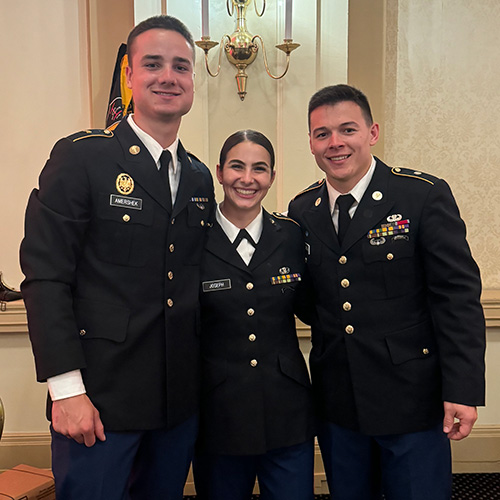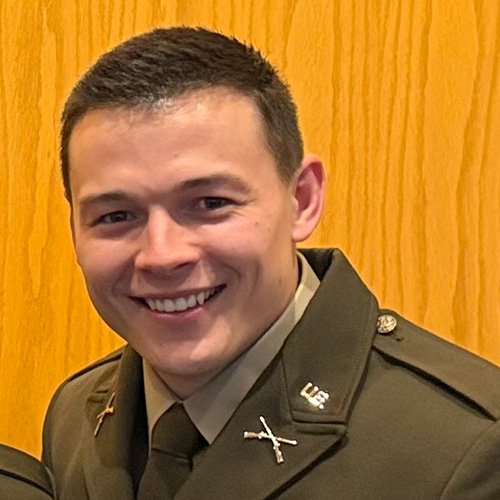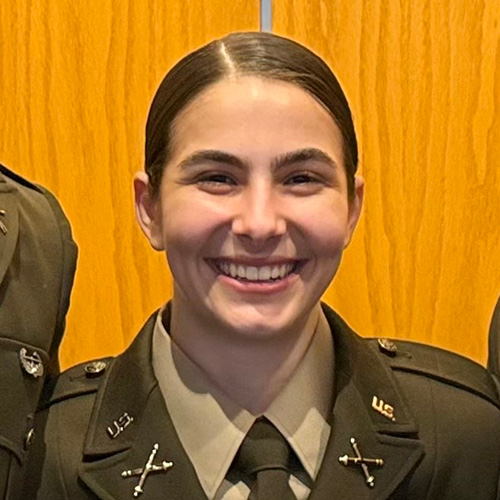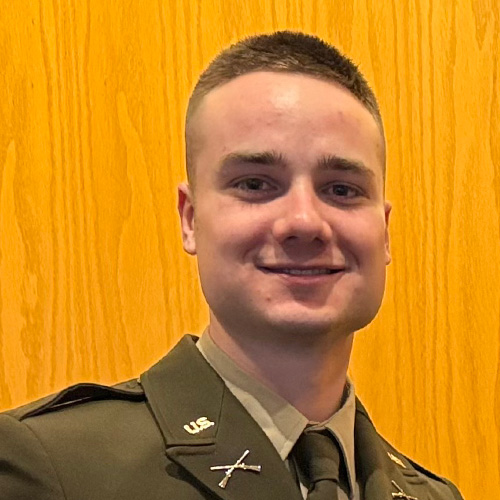While most students acclimate to Lehigh’s mountainside terrain, the Steel Battalion cadets see South Mountain as a training advantage.
For first-year cadets, their first team run starts at Mountaintop. Shouldering a 35-pound rucksack, the cadets hoof down through campus and Southside Bethlehem, across the Fahy Bridge, and up to the northside public library adjacent to Bethlehem City Hall.
Then they turn around and go back.
This training regimen is what makes the members of Steel Battalion elite. Ninety cadets from nine area colleges and universities make up the battalion. Together, they have made a name for themselves among their regional brigade, across the country, and around the world.
Generals ask them how to pronounce “Lehigh” as the team has won three consecutive Ranger Challenges and recently placed ninth among 48 teams at the heralded Sandhurst Military Skills Competition, where they battle alongside other service academies, West Point teams, and the nation’s top allies.
The grit, determination, and legacy-making to bring this consistent excellence are attributed to the hands, hearts, and minds of the students who lead the team, including Angelo Daddona ’25, Sacha Joseph ’25, and Ethan Amershek ’25.
Joining ROTC
 Each of them came to Lehigh through ROTC for different reasons. Amershek’s grandfather was a Marine, while Joseph was inspired and influenced by the service of her step-brothers. Daddona wanted to serve his country and become a leader of character.
Each of them came to Lehigh through ROTC for different reasons. Amershek’s grandfather was a Marine, while Joseph was inspired and influenced by the service of her step-brothers. Daddona wanted to serve his country and become a leader of character.
But their path to college was selective. According to Lt. Col. Preston Jackson, the battalion’s professor of military science and leadership, 12,000 people apply to ROTC. Of those, 2,500 are selected. Of those, only 30% earn a four-year scholarship.
But once a cadet is assigned to a battalion, making a mark is completely a personal choice. All three of these student leaders have done so. At commencement, they will be recognized as distinguished military graduates, a designation reserved for only the top 150 cadets in the country.
Elite Force
As first-year cadets, they, like the rest, learned to structure their college days a bit differently. Three days a week, they began their days with 5 a.m. physical training.
Of course, they went to classes. Daddona is a finance and accounting major, while Amershek studies international relations and supply chain management, and Joseph studies international relations and political science and Arabic.
Twice a week, cadets attended their military science course and had tactical planning for four hours one evening a week. On the weekends, they put those plans into practice with an array of field trainings.
But as leaders, they added another layer of work that was two hours a day, four days a week: Getting ready for Sandhurst.
During their first year, the team placed fourth, and that really motivated them to push harder. Structure, discipline, and perseverance have been the drivers leading them to three years of first-place finishes.
The skills they have had to master include tactical combat casualty care, grenade proficiency, weapons assembly, functional fitness, pistol range, communications, and chemical, biological, radiological, and nuclear readiness.
Their winning record has put a figurative target on their backs as other battalions aim to take them down. But their winning has everything to do with their leadership.
The battalion is self-sufficient. They have the latitude and leeway to execute on their vision. It’s what prompted them to build what’s needed, like monkey bars and a land navigation course, and pursue rigorous training medals, like the Norwegian Foot March.
They want to push the team and know the team’s strengths. And learn to succeed under tremendous pressure.
The top two teams at the Ranger Challenge qualify for Sandhurst. The Steel Battalion takes on the top units from across the country, against states and regions that have hundreds more cadets from which to select the best to compete.
Sandhurst uses the same Ranger Challenge tasks but on steroids and then adds a few other doozies, like night-vision navigation, night-vision range, artillery orders, and the dreaded Crucible.
For these events in the competition, the leaders have minutes to debrief their team, move to a location, and execute. Each year, the battalion has improved its finish, from 32nd place to 18th to 3rd among other U.S.-based brigades.
What’s Next
Jackson couldn’t be prouder. He joined the Steel Battalion four years ago, so he swore in these cadets and soon will move through the ceremony to make them commissioned officers.
“I have never had as fulfilling an assignment as this one in my 30-year military career,” says Jackson. “These leaders are not here for themselves or these accolades. They soon will be officers, leading platoons of 30-40 soldiers. I am proud of their growth and leadership development so much that it’s hard to put into words.”
Each of these cadets is ready for what’s next. They know that the hours, sweat, tears, and work have meant everything. It exemplifies the idea that what leaders put into a task yields something even greater. While they hope they have made an impact, they hope more so that others have learned what’s needed to achieve greatness … and that those future leaders will earn it long after these leaders have moved on.

Angelo Daddona ’25
Role: Infantry
Basic Officer Leadership Course: Fort Benning
Active Duty Station: Fort Bragg, home of the 82nd Airborne

Sacha Joseph ’25
Role: Field Artillery
Basic Officer Leadership Course: Fort Sill
Active Duty Station: Fort Bragg, home of the 82nd Airborne

Ethan Amershek ’25
Role: Infantry
Basic Officer Leadership Course: Fort Benning
Active Duty Station: Fort Campbell, home of the 101st Airborne


